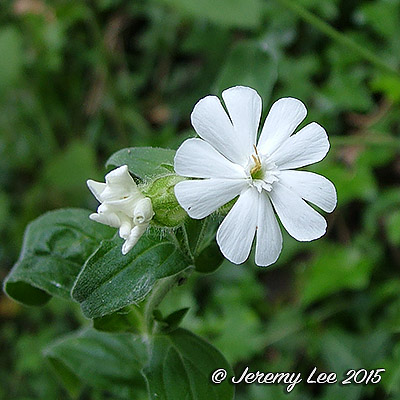
 |
|
Scientific Classifications explained » Amphibians » Ants » Aphids » Bees » Beetles » Birds » Bugs » Butterflies » Caterpillars » Damselflies » Dragonflies » Earwigs » Flies » Frog/Leafhoppers » Fungi » Galls » Grasshoppers » Harvestmen » Hoverflies » Lacewings » Ladybirds » Leaf Mines » Lichens » Mammals » Millipedes » Mosses » Moths » Sawflies » Slugs » Snails » Spiders » Trees » Wasps » Wild Flowers » Woodlice |
UK Nature > Wild Flowers > White Wild Flowers > Silene latifolia

Scientific Name: Silene latifolia Common Name: White Campion In appearance other than colour, Silene latifolia (White Campion) is very similar to the Red Campion, Silene dioica. The two species cope well in overlapping habitats and so are often seen growing together. Up to a metre in height, these hairy perennials have stalkless upper hairy leaves in opposite pairs. The leaves are entire (not toothed) and oval with pointed tips, and near the base of the plant they have unwinged stalks. Flowers of White Campion grow in clusters and each flower has five bi-lobed white petals forming a corolla 2.5 to 3cm across. The calyx is long and inflated but much narrower than in Sea Campion and Bladder campion - the two other white Silene species found in the wild in Britain and Ireland. A mainly lowland perennial, White Campion is less frequently encountered than Red Campion in western Britain and Ireland but it is more widespread and common in eastern England. In areas where there are both Red Campion and White Campion are present you may occasionally find what appear to be White Campion plants with pale pink flowers; these are simply hybrids of the two species. It often grows on waste ground, disturbed roadside verges and arrable field margins that are well drained. Unlike Red Campion, this species shows a marked preference for alkaline to neutral soils and, unlike many wild flowers, the flowers of White Campion remain open as dusk descends, at which time they are slightly scented and attract moths as pollinators. |
|

https://www.uknature.co.uk is a website dedicated to showing the immense diversity of UK nature and wildlife. Our vast range of habitats, from lowland arable to snow covered mountains, from storm-ravaged coastlines to peaceful inland freshwater lakes and rivers, from dry, sandy heaths to deciduous and coniferous forests, all these habitats contribute to the abundance of UK nature. We have wild birds in huge numbers either residing or visiting our shores (597 recorded species as at July 2013) and we must also not forget the humble back garden with its grass lawns, flower beds filled with nectar rich flowers, shrubs and trees, all designed to attract huge numbers of insects such as bees, moths, butterflies and hoverflies; and finally the small ponds which provide safe havens for frogs, toads, newts and even slow worms and grass snakes. www.uknature.co.uk is the showcase for my personal passion, photographing uknature in all its glory. I sincerely hope you all enjoy the fruits of my labours. This site and all images contained therein is © Jeremy Lee 2004 - 2021. All Rights Reserved. Site design by Jeremy Lee. Site development & IT Support by Stuart Lee. |